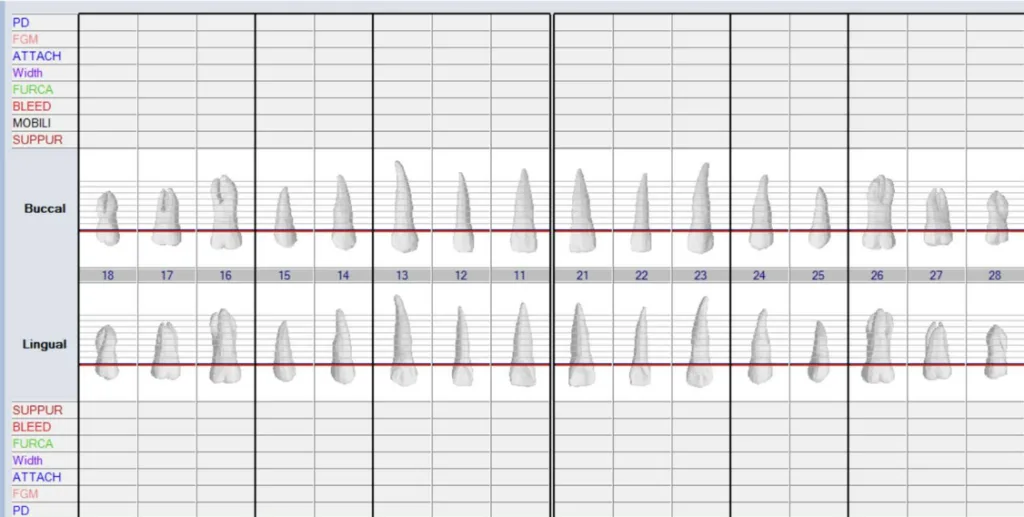Periodontal health is a critical part of your overall oral well-being. To maintain healthy gums and prevent conditions like gingivitis or periodontitis, your dentist may recommend a periodontal examination. But what exactly does that involve? Let’s break down the process and explain why it’s essential to your oral health.
What is a Comprehensive Periodontal Examination (CPE)?

A Comprehensive Periodontal Examination (CPE) is a detailed assessment of your gum health. This exam helps your dentist gather important information about the condition of your gums and supporting structures. The main goals of a CPE are to:
- Diagnose periodontal conditions such as gingivitis or periodontitis.
- Plan treatments to manage any detected issues.
- Establish a baseline for monitoring the progression of any gum disease.
A CPE is usually done for new patients, those transferring from another dental clinic, or those showing signs of periodontal disease. It gives the dentist the information they need to form a treatment plan and monitor how your gums respond to treatment.
Key Components of a Periodontal Examination

Here’s what you can expect during a comprehensive periodontal examination:
- Dental History and Oral Hygiene Assessment The dentist will ask questions about your dental history, focusing on any previous gum treatments like scaling and root planing or gum surgery. They’ll also assess your oral hygiene routine, asking about how often you brush, floss, and use other aids like mouthwash or interdental brushes.
- Plaque and Calculus Assessment Plaque (a sticky film of bacteria) and calculus (hardened plaque) build-up are key factors in gum disease. During the examination, your dentist will check for the presence and severity of both.
- Periodontal Charting This is one of the most critical parts of the exam. Your dentist will use a probe to measure the depth of the pockets between your teeth and gums. This probing depth helps determine how much gum tissue has been lost. A healthy gum pocket is typically 1-3 millimeters deep, while deeper pockets may indicate gum disease.The dentist will also evaluate:
- Gum recession (if the gums are pulling away from the teeth).
- Clinical attachment loss (loss of tissue that connects your gums to your teeth).
- Bleeding on probing, which can be a sign of gum inflammation.
- Furcation involvement, where the bone and gum tissues between the roots of molars have been affected.
- Mobility Assessment The dentist will gently check if any of your teeth are loose, which could indicate damage to the supporting bone or gum tissues.
- Radiographic Evaluation Dental X-rays may be taken to assess the bone levels around your teeth. This helps confirm any findings from the probing and gives a clearer picture of the health of your supporting bone structures.
Note: Sometimes, a full comprehensive examination isn’t necessary. For patients who come in for regular check-ups, your dentist may perform a Periodontal Screening and Recording (PSR). This is a quicker, less detailed exam that uses a special probe with a color-coded band to assess the depth of your gum pockets.
When to Ask for a Periodontal Examination
If you’re noticing any of these signs, a periodontal examination may be in order:
- Bleeding gums during brushing or flossing.
- Swollen or red gums.
- Receding gums, where teeth appear longer due to the gum pulling away.
- Persistent bad breath (halitosis).
- Loose teeth or changes in how your teeth fit together when you bite.
These symptoms can be early signs of gum disease, which, if left untreated, can lead to more serious conditions such as periodontitis.
Preventing and Managing Periodontitis
Preventing periodontal disease starts with good oral hygiene practices and regular dental visits. Here’s how you can keep your gums healthy:
- Brush twice a day with fluoride toothpaste.
- Floss daily to remove plaque between teeth.
- Use mouthwash to help reduce bacteria and freshen your breath.
- Visit your dentist regularly for cleanings and check-ups.
- Quit smoking, as it significantly increases the risk of gum disease.
- Manage other health conditions like diabetes, which can affect your gum health.
If periodontal disease is diagnosed, your dentist will create a treatment plan that may include professional cleanings, deep cleaning procedures like scaling and root planing, and possibly surgical interventions in severe cases.
Conclusion
Maintaining good periodontal health is crucial not only for your teeth and gums but also for your overall health. Untreated gum disease has been linked to other health conditions such as heart disease, stroke, and diabetes. By regularly undergoing periodontal examinations, you can ensure early detection and treatment of any issues, helping you preserve your smile and your health.
If you have concerns about your gum health or need a periodontal examination, don’t hesitate to contact your dental office. Regular monitoring and proactive care can make all the difference in preventing serious gum disease.
Disclaimer
The contents of this website, such as text, graphics, images, and other material are for informational purposes only and are not intended to be substituted for professional medical advice, diagnosis, or treatment. Nothing on this website constitutes the practice of medicine, law or any other regulated profession.
No two mouths are the same, and each oral situation is unique. As such, it isn’t possible to give comprehensive advice or diagnose oral conditions based on articles alone. The best way to ensure you’re getting the best dental care possible is to visit a dentist in person for an examination and consultation.
SAVE TIME AND MONEY AT ANY DENTIST

Less dental work is healthier for you. Learn what you can do to minimize the cost of dental procedures and avoid the dentist altogether!

